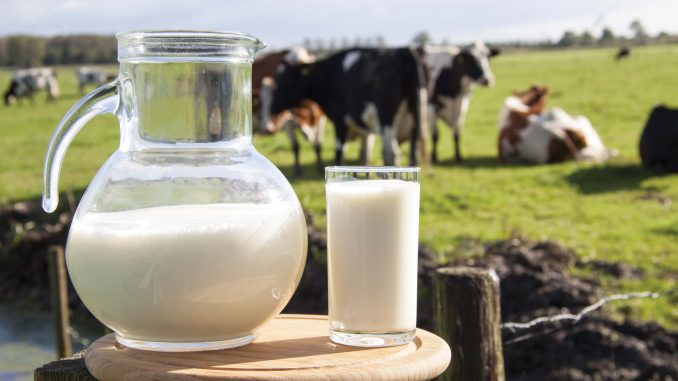
“MILK” THE FIRST FOOD FOR HUMANS
The mere mention of milk might evoke childhood memories of mom scolding you for not finishing the daily glassful or the cute excuses you made to avoid it, or if you were one of those kids who liked milk, competition with visiting cousins in which you used to gulp it down fast to be the first to finish. Love it or loathe it, milk has been an important part of our diet for sure.
Yes … The first food for all humans “MILK” is the richest natural food in terms of nutrient contents necessary for our body function, proper growth and maintenance.
The usage of milk is not new for us; it has been part of our diet since time immemorial. Let’s take a look at the nutrient value and benefits Milk and its products provide to our body.
Milk is a food which contains plenty of carbohydrates, lipids (fat) and protein, while various milk products processed in different ways can provide a whole list of nutrients.
While everyone and their grandmother know that drinking milk gives you calcium, you might do well to remember that if you include milk or its products like cheese or yogurt, your body not only gets enough calcium (best nutrient for healthy bones) but also –
- Phosphorous- for proper energy release
- Magnesium- for muscle function
- Protein- for proper growth and repair process
- Vitamin B12- for production of your cells
The consumption of milk by human beings is always required throughout the life regardless of the age or gender.
SOURCE OF MILK
Milk can be obtained from many different sources, such as cow, buffaloes, goats and sometimes exotic animals like yaks and camels. Among these, cow milk is conventionally considered to be the most popular and richest in nutrients. It is revealed in various scientific testing that whatever the milk source is, it is greatly similar in terms of properties. However, the content of the nutritional elements present may slightly vary from one source to another.
FORMS OF MILK
Dried Milk:
It’s a process of evaporating and drying of fresh milk on specific machinery by the manufacturers. During this entire process, proper care is taken to maintain same nutrient value as available in the fresh milk. This process often includes fortification with certain vitamins such as vitamin D and minerals in the dried milk.
Dried milk is easy to use and predominantly available in your local market in two varieties:
- Full- fat dry milk
- Fat-free dry milk
Full-fat dry milk usually has 6-9 month of shelf life and fat-free milk has a shelf life of two years. As a precautionary measure always remember once the pack is opened, you should store it in cool, dry place away from contact of direct sun rays. Also, prevent them getting moist for better life
Long-Term Milk:
Long term milk is created through the process of pasteurization. Pasteurization is the process of exposing milk to high temperature and sudden cooling. This process helps to kill the pathogenic bacteria present, making the food product safe for consumption. Pasteurized milk is later packed in specially- made packets. The milk obtained expires in six months. Once the packet is opened, consume within one week.
Fresh Milk:
The milk is collected, undergoes a heating process, followed by cooling. This milk should be consumed within a week as it spoils fast.
Domestic Condensed Milk:
It is produced through a process which involves adding a large amount of sugar. Sugar is added to pasteurized milk which turns to condensed form. This milk is rich in fat and milk cream. This form of milk cannot be consumed as a milk substitute but it is used is various milk preparations like desserts, ice-creams etc.
MILK PRODUCTS
A variety of milk products is available in your local markets. Many times you don’t even notice the food you are consuming contains milk.
Let’s check the list of healthy milk products available.
Curd, yogurt and different types of cheese:
These products are prepared from fresh milk. Since they are made of fresh milk the nutrient value of the product remains same. People who dislike the flavor of milk can look to these milk substitutes to reach the body’s nutrient requirement.
There are many flavors available in every product these days like strawberry, chocolate, pineapple. Choose according to your own preference but remember the proportion of calories might vary.
Creamy Cheese, cream, butter, ice cream
These are the products derived from milk but they are a fat substitute. The manufacturing of these products requires more of milk fats with a little amount of milk. They are not milk substitutes, and they cannot replace it.
Bread, Cookies and Cakes
These are products which require milk in small quantity for preparation. Among all these products milk acts as an ingredient which helps in enhancing the flavor of the products.
HEALTH BENEFITS OF MILK:
The protein component present in milk is composed of numerous specific proteins. Casein is the primary group of milk proteins in milk. The major minerals found in milk are calcium and phosphorous. There are some major vitamins also present in milk like vitamin A, D, E, and K. The plenty of calcium, proteins and vitamins present in milk make it a food, medicine and a healer at the same time.
- Milk helps in maintaining the glaze, a natural shine on skin and hairs.
- Milk provides instant energy, increases strength, improves memory, maintains strength and promotes long life.
- Milk helps in building and maintaining strong bones and teeth
- Milk is recommended as wholesome food for invalids. Milk diet is very much beneficial to put on weight.
- Milk acts as a very effective medicine for hyper acidity and other acidic conditions of the stomach.
